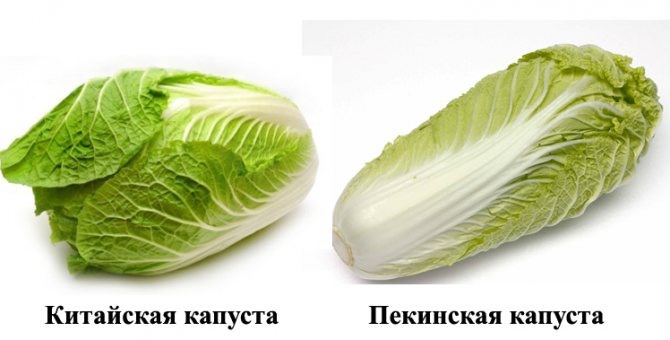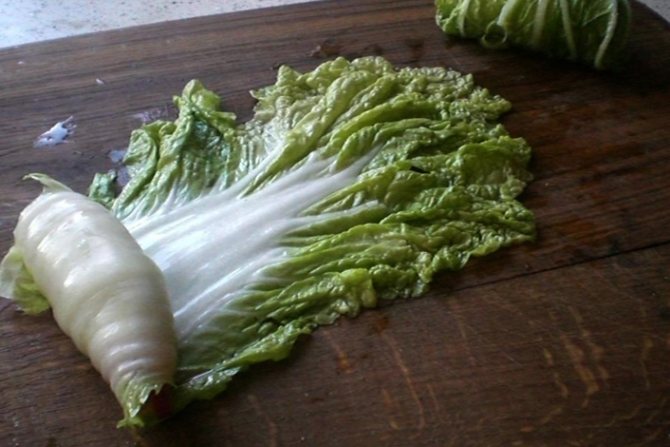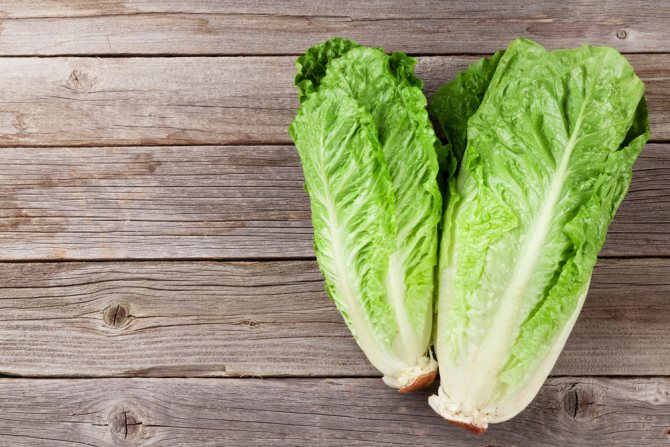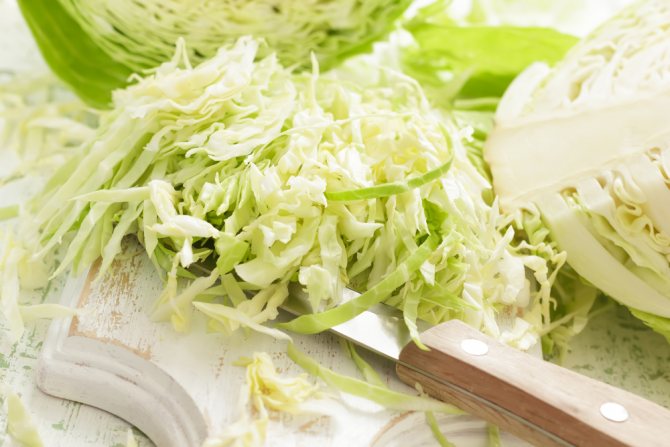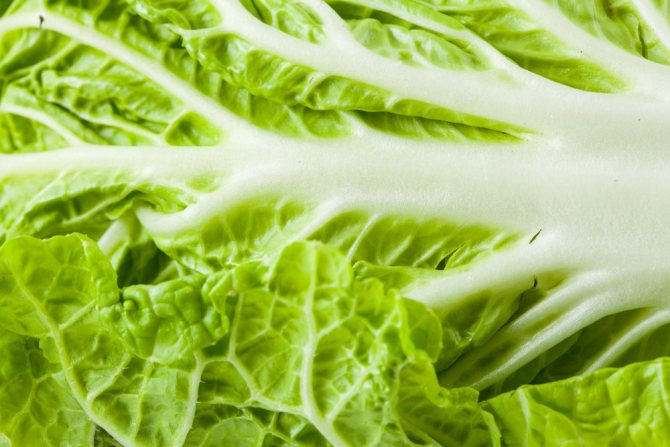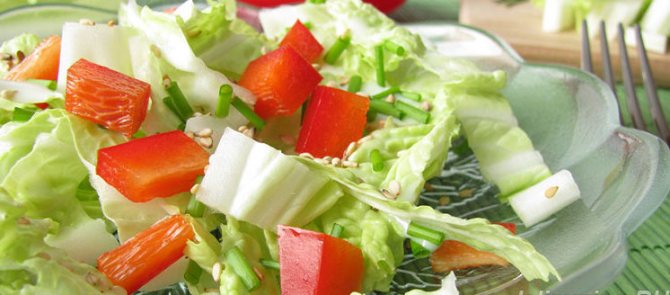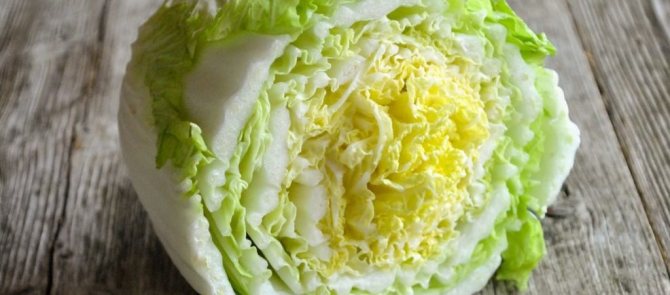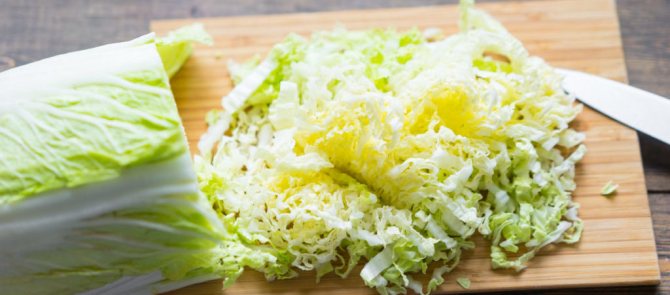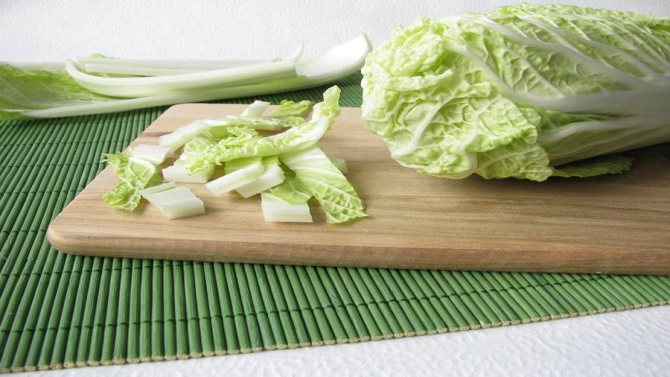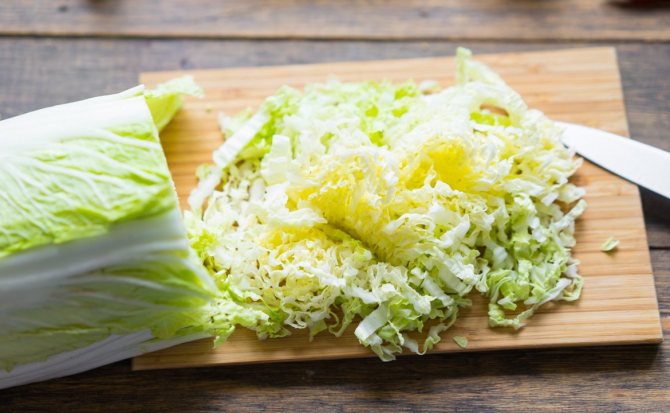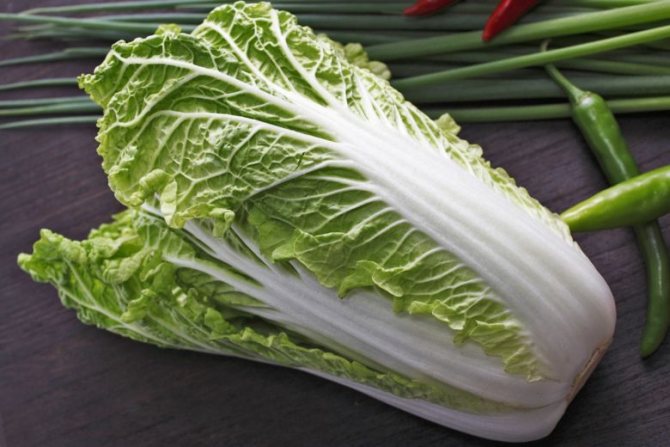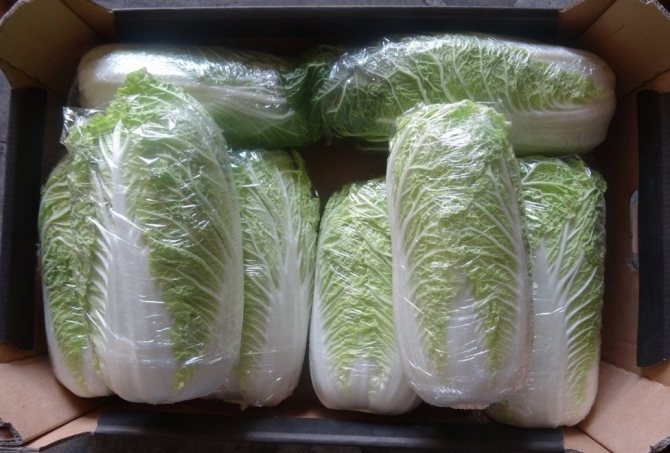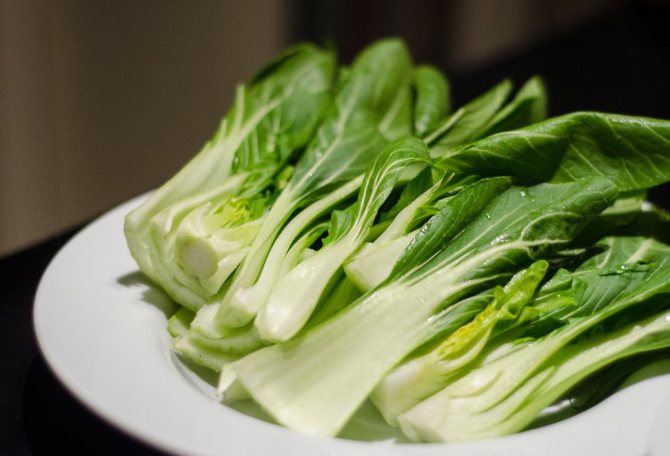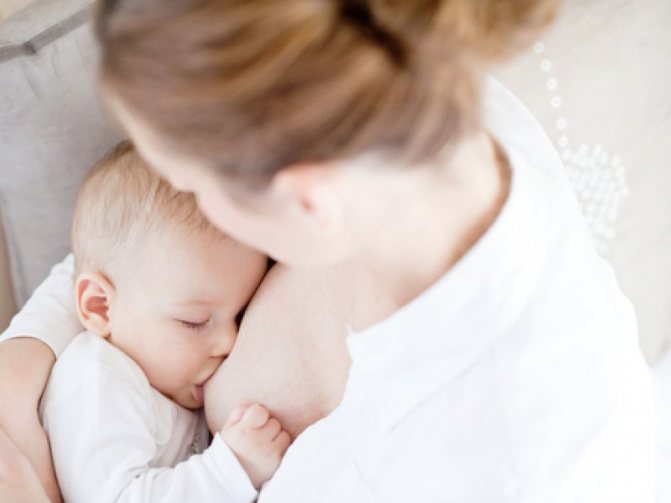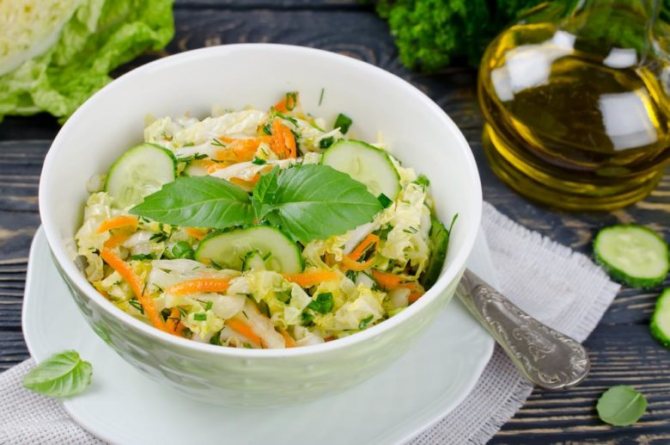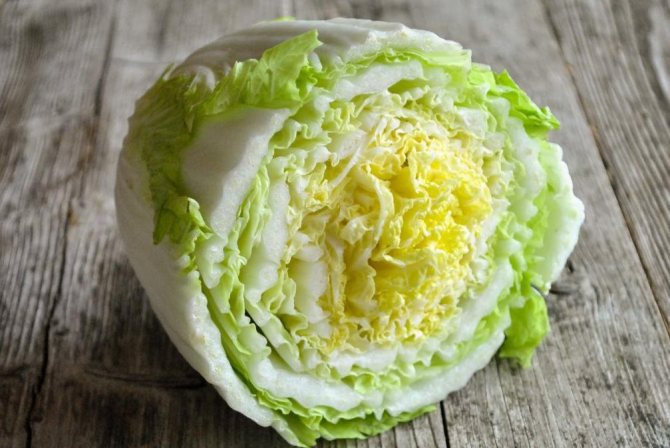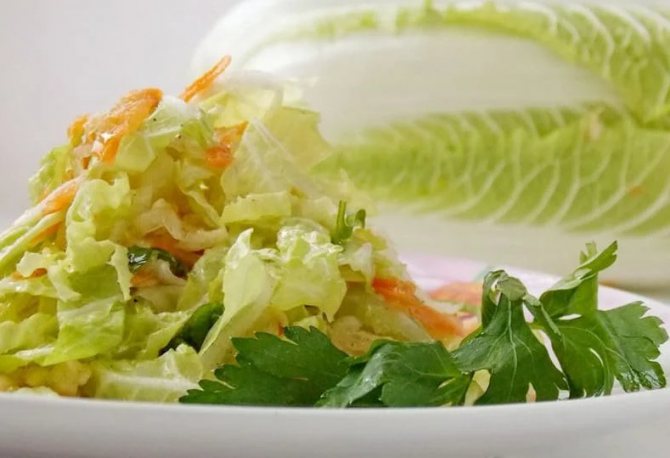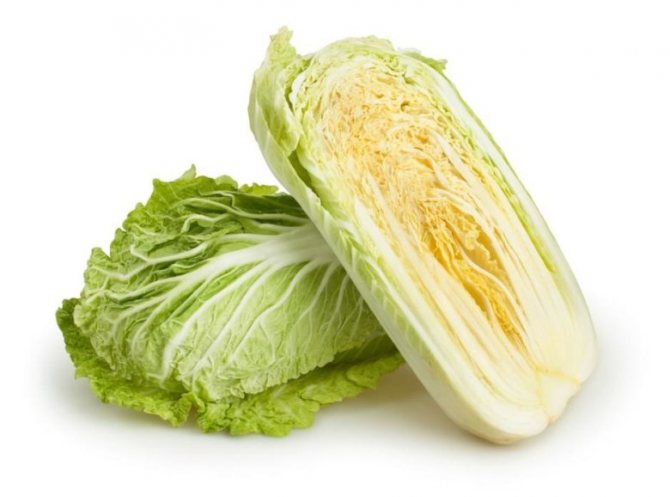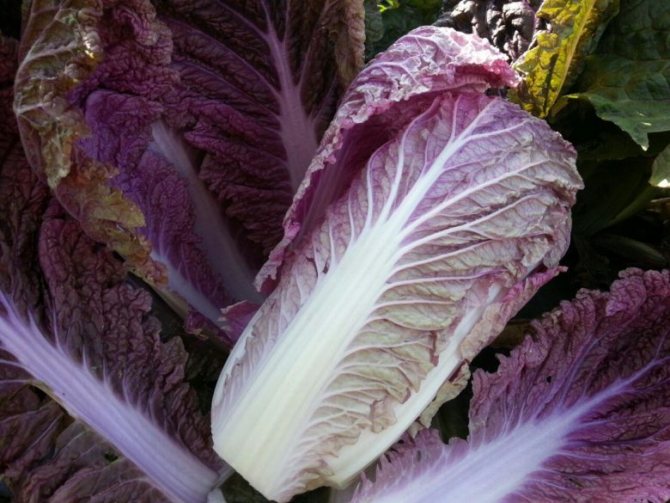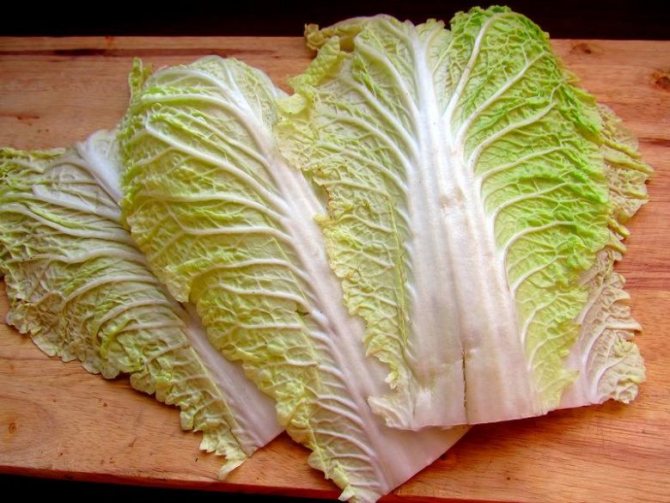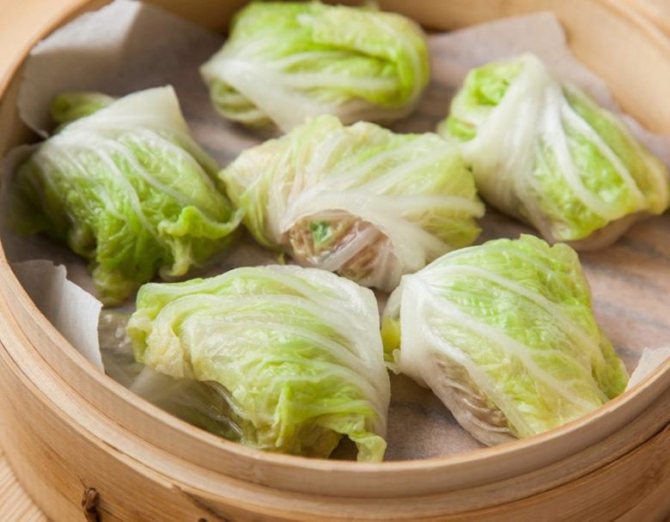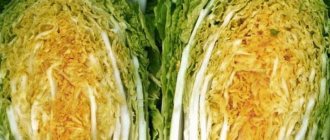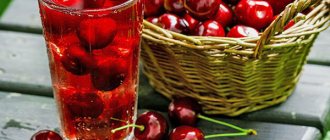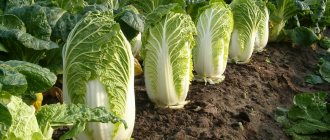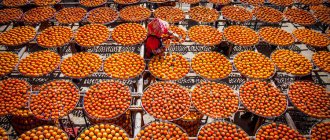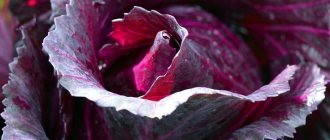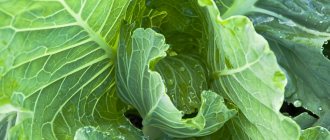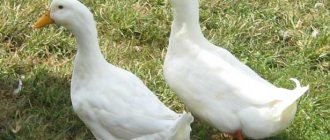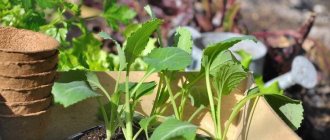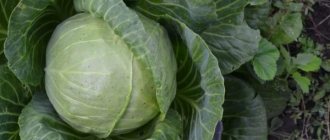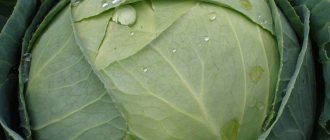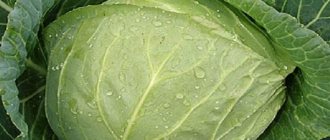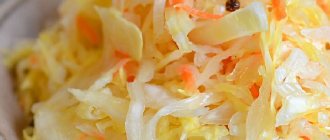Peking cabbage (also known as Chinese cabbage, lettuce, or petsai) is a popular member of the Cruciferous family that has longer, thinner leaves. It is widely popular all over the world and is used in folk and evidence-based medicine and cooking.
The abundance of vitamins, minerals and antioxidants determine the benefits of Chinese cabbage for almost all body systems, and its regular intake reduces the risk of developing the most common diseases.
What is Chinese cabbage
In nature, the plant is a biennial. In culture, it is grown as an annual. The popular name that came from the East is petsay. Depending on the variety, fragile leaves fold into a loose head of cabbage or a loose rosette. The leaves are slightly wavy, pimpled. A dense white vein runs in the center.
The color of the leaves is from bright green to yellowish. In the context of the head of cabbage yellow-green. The first crop is harvested in June; the harvest continues all summer, depending on the sowing time.
According to some sources, the vegetable has been grown in China for over 5,000 years. Inhabitants of the East believe that daily or frequent inclusion of cabbage in the menu increases life expectancy.
Breeding features
Peking cabbage is grown using a seedling and non-seedling method. Direct sowing into the soil is preferable for the southern regions or the earliest varieties, the planting of which occurs in late spring, when the soil warmed up to a temperature of 15 degrees. The seedling method has become widespread in the cultivation of medium and late varieties of cabbage.
Additional Information! Experts recommend planting hybrid varieties bred for a specific region in the garden. Such cabbage is better adapted to weather conditions and has a stronger immune system.
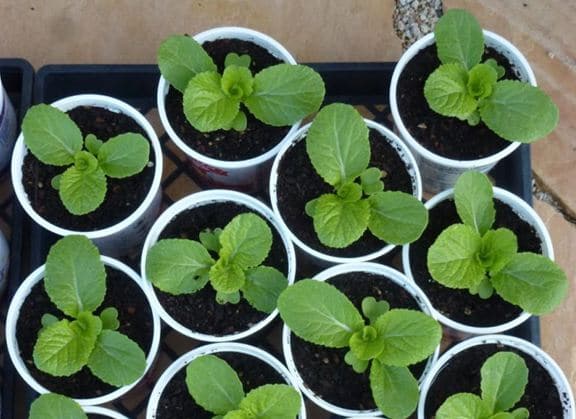
Seedling of Chinese cabbage
Seedless method
In southern regions or when using early varieties, direct sowing of seeds into the ground is allowed. Directly planted cabbage has a number of advantages over seedling cabbage. The bushes have a more developed root system, are less demanding for a lack of moisture in the later stages of ripening. This cabbage gives an earlier harvest than the heads of cabbage obtained through seedlings.
For sowing seeds, it is necessary to prepare the beds. The soil is well dug up and loosened, removing weeds and large roots. Trenches with a depth of 4-5 centimeters are made along the entire length of the bed.
The planting material is pre-soaked in a manganese solution and dried. Seeds are spread on the bottom of the trench 3-4 pieces at intervals of 20-25 centimeters. The seeds are covered with soil and watered abundantly. When the seedlings grow up, they are thinned out, leaving 1 in each planting place.
Seedling method
The seedling method is suitable for medium to late ripening cabbage. Seedlings are actively used in the central and northern regions, and they are also grown in greenhouses.
To breed cabbage seedlings, it is important to follow a number of rules.
- Preparation of planting material. Peking cabbage seeds are tested for germination. To do this, they are soaked in warm water. Floated seeds are not used for planting. The rest are soaked for 30 minutes in a manganese solution.
- Soil preparation. For seedlings, use a specialized purchase of soil.You can also prepare the soil yourself. To do this, mix sod land with peat in equal proportions. 10 grams of wood ash and 10 grams of complex compounds are added to the mixture for every 10 kilograms of soil.
- Sowing. The planting containers are filled with prepared soil. 2-3 seeds are buried in each container. The embedment depth is no more than 1.5 centimeters. Seedlings are watered abundantly.
- Germination. Seedlings are covered with foil and left to germinate in a warm place. After the formation of 2-3 leaves in the seedlings, thinning is carried out, leaving 1 strong seedling.
- Transfer to the ground. Quenching is carried out 1-2 weeks before transplantation. Plants are planted in a permanent place 3 weeks after germination. At the time of transplantation, the cabbage should have 5-6 large leaves.
Note! The use of peat pots allows you to minimize stress when replanting Peking in open ground. Seedlings are buried in the soil along with the container. Subsequently, it dissolves, giving the plants additional nutrients.
Vegetable selection rules
Only fresh, high-quality cabbage will bring real benefits, will be juicy and tasty. When choosing a vegetable, five criteria are followed.
- The appearance of the leaves. They should be strong, discard the withered and sluggish right away.
- Head of cabbage color. Green heads are more fibrous. Light - more juicy, fragile.
- Density. A head of cabbage of medium density - not hard, but also not loose, elastic to the touch.
- The size. Heads of medium weight are chosen - they are the most juicy and healthy.
- Freshness. Packaged cabbage is examined very carefully. Condensation is not allowed on the inner surface of the bag. In a good product, the leaves are whole, without spots, dried, yellowed areas.
Interesting: The benefits and harms of fructose, how it differs from sucrose
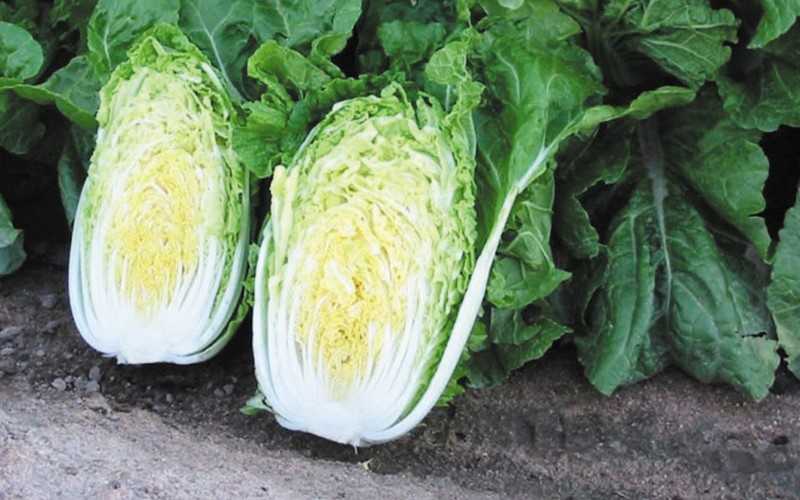

Wash the cabbage just before cooking. Previously, it is disassembled into leaves, each leaf is washed separately.
Beijing: features, differences from Chinese and other types
Peking cabbage is a low-calorie vegetable that combines the flavors of cabbage and lettuce.
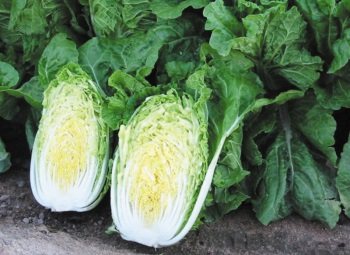

The main difference between this variety and others is the size and shape of the leaves: they are oblong, with wavy edges, wrinkled, white at the base and light green at the ends.
Second an important difference is lower calorie content (which makes this vegetable a dietary one) and a delicate pleasant taste that complements the dishes.
Chinese cabbage with Peking cabbage are practically "brothers". Many people even think that this is the same vegetable, but there are still differences between them.
Peking cabbage is a head of cabbage with light, as if slightly wrinkled leaves. The Chinese grows without the formation of a head - like a petiole, from which straight, almost smooth leaves extend. The Peking variety tastes more tender, fleshy, and juicy.
Why is Chinese cabbage useful?
What are the health benefits of Chinese cabbage? In terms of the content of valuable substances and vitamins, it surpasses many vegetables. The leaves do not need to be boiled. The greatest benefit comes from the use of Peking cabbage in a fresh, raw form. The following properties are especially appreciated:
- relieves fatigue;
- increases efficiency;
- increases appetite;
- normalizes the emotional background;
- improves heart function;
- smoothes the symptoms of atherosclerosis;
- eliminates frequent constipation;
- stimulates the digestive tract;
- normalizes high blood pressure;
- reduces glucose levels in diabetes mellitus;
- relieves the condition with stomach ulcers and gastritis;
- strengthens the immune system;
- relieves swelling;
- accelerates the treatment of anemia;
- cleans the blood;
- removes toxins;
- reduces the severity of allergies;
- reduces pain in gout.
Petsai is useful during pregnancy and breastfeeding. At this time, good nutrition is important for a woman.The vegetable saturates the body with iodine, potassium, vitamins and other valuable substances.
Safety and contraindications
In rare cases, eating Chinese cabbage can harm the body, as side effects may develop. These include:
- Allergic reactions. They are extremely rare and are characterized by a mild course. Cases of cross-allergy have been described in the presence of sensitization of the body to other members of the Cruciferous family.
- Exacerbation of chronic diseases of the gastrointestinal tract. The plant (especially in cabbage juice) contains extractive substances that irritate the mucous membranes. With excessive intake, an exacerbation of gastritis, gastric ulcer and duodenal ulcer and other pathologies is possible.
To whom is Chinese cabbage contraindicated and possible harm?
Chinese cabbage is a hypoallergenic, vitamin-rich vegetable. The harm of Chinese cabbage in comparison with its benefits is insignificant.
Contraindications are reduced to problems with the gastrointestinal tract. It is not recommended to abuse the vegetable with exacerbation of cholecystitis, pancreatitis, gastritis with high acidity. The vegetable will aggravate the condition with diarrhea, flatulence, colic.
Peking cabbage is incompatible with dairy and sour milk products. Using it at the same time with cottage cheese, sour cream, cheeses provokes diarrhea.
There is always the possibility of purchasing a vegetable with a high nitrate content. Before cooking, the head of cabbage is soaked for an hour and a half in clean water, then washed under the tap.
Calorie content and nutritional value
The calorie content of Peking is very low - 15 kcal per 100 g of product, which makes it a dietary dish.
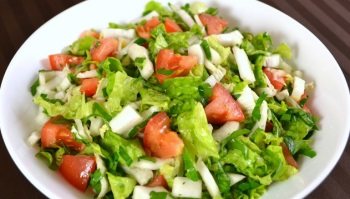

The nutritional value:
- proteins - 1.1 g;
- fats - 0.3 g;
- carbohydrates - 1.1 g;
- fiber - 1.7 g
The amount of carbohydrates in cabbage is extremely low.
Therefore, it is included in many diets for losing weight.
Healing recipes
The beneficial properties of Chinese cabbage are used to treat diseases. More often it is included in the diet in a fresh, boiled, stewed form. Sometimes decoctions are prepared on the basis of a vegetable.
- Insomnia. You need to prepare a decoction of Peking cabbage. About 150 g of leaves are poured into 350 ml of water, boiled over low heat for half an hour. Filter, take a glass at night.
- Mastopathy. The sheet is washed under running water, lightly sprinkled with salt and kneaded. When the juice comes out, apply it to the sore spot. In addition, freshly squeezed juice from Peking cabbage is taken orally.
- Cough. The leaves are dipped in hot water for a few minutes. The liquid is drained, a thin layer of liquid honey is applied to the surface of the leaves. Leaves are applied to the chest and back, honey to the skin. They fix it with cling film, a bandage, put on a tight-fitting T-shirt. The compress is left overnight.
- Bronchial asthma. Throw 20 g of Chinese cabbage seeds into a glass of boiling water. Pour into a saucepan, bring to a boil, evaporate over low heat for up to half an hour. Take half a glass chilled twice a day.
- Inflamed eyelids. Boil cabbage, knead, add a little olive oil. The mass is applied to closed eyelids, held for up to half an hour.
Interesting: Pumpkin juice - useful properties and contraindications for women, men and children
Peking cabbage is useful not only for women, but also for men. The inclusion of a vegetable in the daily diet prevents prostate diseases, has a positive effect on the activity of sexual activity.
Content and nutritional value
The presence of proteins, carbohydrates and dietary fiber in this vegetable crop is minimal, and the concentration of nutrients and trace elements is quite high. If the energy value of white cabbage is 25 kilocalories, then in Chinese salad this figure is two times lower (13 kcal). In this way, benefits of Chinese cabbage not only in a high concentration of nutrients, but also in low indicators of the nutritional value of the product.
| Vitamin content per 100 gr. product, mg | The content of trace elements per 100 gr. product, mg | ||
| Vitamin A | 4468 IU | Potassium | 252 |
| Vitamin C | 45,0 | Calcium | 105 |
| Vitamin B1 | 0,040 | Iron | 0,80 |
| Vitamin B2 | 0,070 | Sodium | 65 |
| Vitamin B6 | 0,194 | Magnesium | 19 |
| Vitamin E | 0,09 | Manganese | 0,159 |
| Vitamin B9 | 66 mcg | Copper | 0,021 |
| Vitamin PP | 0,500 | Phosphorus | 37 |
| Vitamin K | 45.5 mcg | Zinc | 0,19 |
The following features of the vegetable are also noteworthy:
- In addition to these constituent elements, this vegetable culture contains a lot of water, fiber and dietary fiber. The presence of proteins (lysine), folic acid and latucine in the vegetable has a general strengthening effect on the body: its protective properties increase, sleep and pressure are normalized.
- Citric acid as a component of petsai allows you to preserve the beneficial properties of products in freshly cut salads for a long time.
- Peking cabbage can be safely attributed to the category of products that are effective in losing weight, because even with a low calorie level, our body will need a lot of energy to digest this type of salad. That is, more calories are burned than the individual receives.
How is Chinese cabbage used in dietetics
Peking cabbage is often used for weight loss. With a low calorie content, it creates a feeling of satiety, supplies the body with the necessary vitamins and minerals. Fiber promotes the elimination of toxins, cleanses the intestines, stimulates its work. It is believed that Chinese cabbage has a negative calorie content. To digest it, the body spends a lot of energy.
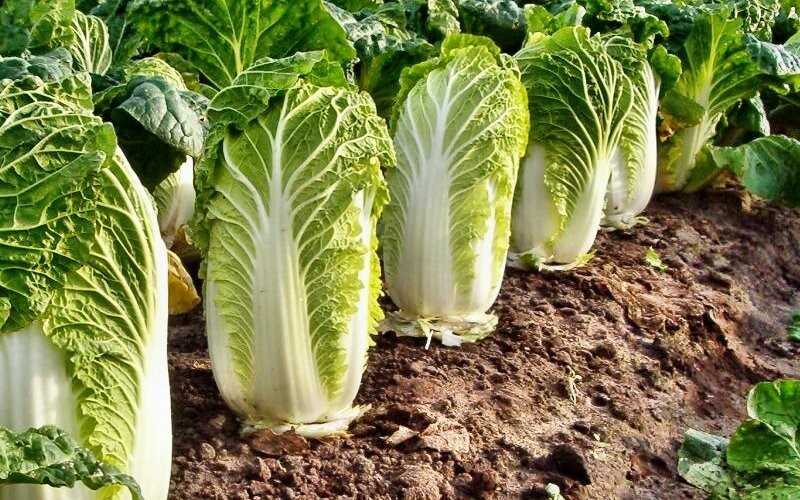

During the diet, the vegetable can be eaten in any quantity.
The essence of the diet
The basis of the diet includes vegetable salads from raw Chinese cabbage and lean boiled meat. It is allowed to eat up to 400 g per day of boiled beef, chicken, turkey.
Protein foods are eaten in the morning. After 6:00 pm, only lean salads are permitted. The diet is designed for a week. Its developers promise to reduce weight by 3-4 kg.
Examples of low-calorie meals
Peking cabbage goes well with chicken, seafood. Lean salads made with fresh vegetables and herbs are more suitable for the diet. There are three most common recipes.
- Base. Cut the required amount of cabbage, add a little salt. For dressing, mix a spoonful of lemon juice and sunflower oil.
- With greens. Leaves are cut into small pieces. Finely chop a bunch of any greens - a mixture of parsley, basil, dill, rosemary, cilantro. Mix all the ingredients, add salt, season with olive oil and lemon juice.
- Japanese. Cut an equal amount of fresh cucumber and Chinese cabbage. For dressing, mix the grated clove of garlic and a couple of tablespoons of soy sauce. Stir, sprinkle with sesame seeds.
Many people dislike the taste of the thick white vein. To get the most out of a vegetable, you don't need to cut it out - it contains much more valuable nutrients than tender leaves. The veins are eaten fresh, pickled, fermented, salted.
Use in old age
There are no contraindications for the use of Peking cabbage in old age, except for the individual intolerance of the product. Peking cabbage for them will have the same beneficial properties as for adult men and women.
In old age, the prevention of diseases of the heart, blood vessels, stomach, brain and other organs is of great importance, since the elderly are more susceptible to diseases.
Slimming application
Chinese cabbage is low in calories (no more than 14 kcal per 100 g), so it helps to effectively lose weight. When it is digested, the body expends more energy than it receives. Nutritionists classify this cabbage as a negative calorie food group.
In addition, almost all leafy vegetables (and nappa are no exception) are good for your figure due to the complex mechanism of increasing the metabolic rate they trigger.
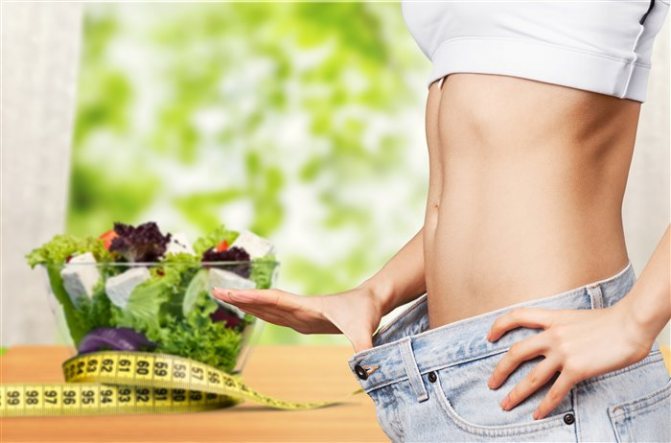

Thus, on a diet, you can use the product in unlimited quantities and not be afraid that calories are deposited on the stomach and hips in the form of extra pounds. Features of the use of Chinese cabbage for various diseases
The advantages of cabbage and any other food product are in the complex effect due to the multicomponent composition.If for a healthy person there are no restrictions on the use of fresh vegetables, then for people with chronic diseases there are prohibitions. They relate to the amount consumed, the method of preparation and the combination with other products.
With diabetes
With unstable blood sugar levels, slow metabolism, hypertension, and obesity, Chinese cabbage is very beneficial. Fortunately, this is reflected in the stimulation of the production of digestive enzymes and the acceleration of metabolic processes in cells.
This is the key to raising blood glucose levels and making you feel better. In addition, the components of the composition purify the blood, lower blood pressure and help to lose weight.
With gastritis
In this disease, any type of cabbage is contraindicated. Coarse fiber is difficult to digest; active synthesis of digestive juice is required, which stimulates the production of hydrochloric acid and enzymes.
A person with gastritis has heartburn, abdominal pain, and a change in acidity levels is possible. Any diseases of the stomach and duodenum are a direct contraindication to eating vegetables.
Bloating (flatulence)
With a tendency to increase gas production, cabbage is sometimes included in the diet. To make the intestines more responsive to plant foods, it heats them up. With flatulence, you can eat Chinese cabbage stew with minimal salt and no spices.
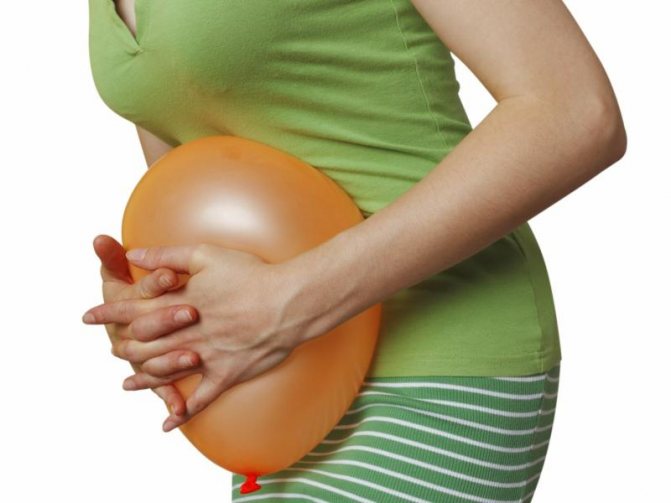

The rule of individual product tolerance applies here. Not all vegetables cause bloating, but if flatulence occurs, the cabbage is thrown away.
With gout
Chinese cabbage is good for fresh gout. Its role is to stimulate the urinary system and cleanse the body of salts and uric acid. It does not contain puric acid, which aggravates the course of the disease. Doctors recommend eating fresh cabbage and adding it when making vegetable juices.
Use in cosmetology
Cabbage juice and leaves are used as natural cosmetics. Chinese cabbage contains many vitamins, minerals and acids that are essential for healthy skin. There are three most common recipes.
- Enlarged pores. Juice is squeezed out of the white part of the leaves, and the face is wiped daily. Excessive oiliness leaves, pores are narrowed.
- Dry skin. The leaves are scalded with boiling water, the dense white part is slightly beaten with a hammer. The surface of the leaves is smeared with a small amount of olive oil, applied to the face. Hold for 20 minutes, remove, wash with a decoction of chamomile.
- Peeling. The leaves are boiled in milk, crushed with a blender. The mass is applied to the face, kept for up to half an hour.
Interesting: How to use red wine correctly, the benefits and harms
Chinese cabbage is good for dandruff. The scalp is smeared with vegetable oil, crushed fresh leaves are applied on top. For severe dandruff, the procedure is repeated twice a day for two weeks.
Bone health
Calcium, which is part of Chinese cabbage, is useful for bones and teeth, participates in cellular metabolic processes, is important for muscles, for coordination of movements. Normalizes blood clotting if it is low. Has anti-inflammatory effect, supports the nervous system.
Vitamin K maintains calcium balance.
Included in magnesium helps to maintain the strength of bone tissue.
Phosphorus - an irreplaceable participant in metabolic processes, useful for teeth and bones.
Cooking Tips
Salad is found in the cuisine of different countries. In European countries, it is eaten mostly fresh. Japanese cuisine offers fresh and boiled Chinese cabbage. Asians prefer to pickle it.
Salads
The most common way to prepare Chinese cabbage is with various salads.Leaves are usually not cut, but torn by hand into small pieces. The vegetable goes well with other fresh vegetables, seafood, sausages, ham, meat. Salads are usually seasoned with vegetable oil, soy sauce, less often with mayonnaise. It is not recommended to use cream and yoghurt as a dressing.
Antineoplastic properties
Reducing the risk of prostate cancer, research confirms.
Chinese cabbage and other cruciferous vegetables are recommended for cancer-fighting.
A number of studies do not support the effect of folic acid on carcinogenesis. But they found an inverse association between high dietary folate intake and a lower risk of colorectal cancer and prostate adenoma.
Fiber supports gut health and may also lower the risk of colorectal cancer.
Description of pak choy Chinese cabbage
The Asian leaf culture is widely known among agronomists and gardeners as mustard or celery cabbage. She owes such names to her amazing taste. Its leaves are always juicy and incredibly crunchy. As for the taste, it amazes with its spicy, unobtrusive notes and exquisite aftertaste.
All varieties of Chinese cabbage are used in cooking in almost any form. Pak Choi is great for making appetizers and salads. But this vegetable is no less tasty in fried, stewed, baked, boiled form. Asian women make delicious pickles and marinades. Experienced chefs advise you to dry pak choi to enjoy it at any time of the year.
Important! The leaves of young cabbage have the most piquant, delicate and refined taste.
A Chinese woman is not only able to become a table decoration, she looks like a real work of art even in the garden. After all, cabbage forms a decorative rosette of leaves of an unusual shape, which looks very elegant. The height of the culture can vary from 20 to 50 cm, and the diameter from 40 to 45 cm. The color of the leaves and petioles varies, reaching the most unusual shades of green. There are even the most beautiful purple specimens. All of these criteria depend on the variety of cabbage.

